Related Research Articles

Bhang is an edible preparation made from the leaves of the cannabis plant originating from the Indian subcontinent. It has been used in food and drink as early as 1000 BC in ancient India. Bhang is traditionally distributed during the spring festival of Maha Shivaratri and Holi. Bhang is mainly used in bhang shops, which sell the cannabis-infused Indian drinks bhang lassi and bhang thandai.

Vermicelli is a traditional type of pasta round in section similar to spaghetti. In English-speaking regions, it is usually thinner than spaghetti, while in Italy, it is thicker.

Naan is a leavened, oven-baked or tawa-fried flatbread, which is found in the cuisines mainly of Iran, Afghanistan, Central Asia, the Indian subcontinent, Indonesia, Malaysia, Myanmar, and the Caribbean.

Kulfi is a frozen dairy dessert from the Indian subcontinent. It is often described as "traditional Indian ice cream". Kulfi originated in 16th-century Delhi during the Mughal era. It is part of the national cuisines of India, Pakistan, and Trinidad and Tobago. It is also popular in Bangladesh, Myanmar, Nepal, Sri Lanka, and the Middle East.
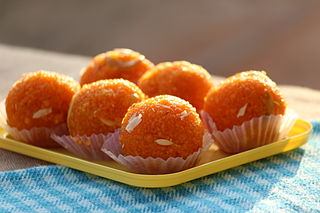
Laddu or laddoo is a spherical sweet from the Indian subcontinent made of various ingredients and sugar syrup or jaggery. It has been described as "perhaps the most universal and ancient of Indian sweets."

Kheer, also known as payasam or payesh, is a pudding/porridge popular in the Indian subcontinent, usually made by boiling milk, sugar or jaggery, and rice. It can be additionally flavored with dried fruits, nuts, cardamom and saffron. Instead of rice, it may contain cracked wheat, vermicelli (sevai) or tapioca (sabudana).

A falooda is a Mughalai cold dessert made with vermicelli. It has origins in the Persian dish faloodeh, variants of which are found across West, Central, South and Southeast Asia. Traditionally it is made by mixing rose syrup, vermicelli, and sweet basil seeds with milk, often served with ice cream. The vermicelli used for preparing falooda is made from wheat, arrowroot, cornstarch, or sago.

Rajasthani cuisine is the cuisine of the Rajasthan state in North West India. It was influenced by various factors like the warlike lifestyles of its inhabitants, the availability of ingredients in an arid region and by Hindu temple traditions of sampradayas like Pushtimarg and Ramanandi. Food that could last for several days and could be eaten without heating was preferred. Scarcity of water and fresh green vegetables have all had their effect on the cooking. Signature Rajasthani dishes include Dal Baati Churma, Panchratna Dal, Papad ro Saag, Ker Sangri, Gatte ro Saag. It is also known for its snacks like Bikaneri bhujia, Mirchi bada and Kanda kachauri. Other famous dishes include Dal Baati, malaidar special lassi (lassi) and Lashun ki chutney, Mawa lassi from Jodhpur, Alwar ka mawa, Malpauas from Pushkar and rasgulla from Bikaner, "paniya"and "gheriya" from Mewar. Originating for the Marwar region of the state is the concept Marwari Bhojnalaya, or vegetarian restaurants, today found in many parts of India, which offer vegetarian food of the Marwari people. The history also has its effect on the diet as the Rajputs preferred majorly a non-vegetarian diet while the Brahmins, Jains, Bishnois and others preferred a vegetarian diet. So, the state has a myriad of both types of delicacies.

Idiyappam, also known as string hopper, indiappa, noolputtu, noolappam, or ottu shavige, is a string hopper dish originating from southern India. It consists of rice flour pressed into noodles, laid into a flat disc-like shape and steamed. The dish also spread to Southeast Asia, where it is called putu mayam in Malaysia and Singapore, and putu mayang in Indonesia.

Dahi puri is an Indian snack food which is especially popular in the state of Maharashtra. The dish is a type of chaat and originates from the city of Mumbai. It is served with mini-puri shells (golgappa), which are also used for the dish pani puri. Dahi puri and pani puri chaats are often sold by the same vendor.

Sindhi cuisine refers to the distinct native cuisine of the Sindhi people from Sindh, Pakistan. Sindhi cuisine has been influenced by Central Asian, Iranian, Mughal food traditions. It is mostly a non-vegetarian cuisine, with even Sindhi Hindus widely accepting of meat consumption. The daily food in most Sindhi households consists of wheat-based flat-bread (Mani) or rice accompanied by two dishes, one gravy and one dry with curd, papad or pickle. Freshwater fish and a wide variety of vegetables are usually used in Sindhi cuisine. Restaurants specializing in Sindhi cuisine are rare, although it is found at truck stops in rural areas of Sindh province, and in a few restaurants in urban Sindh.
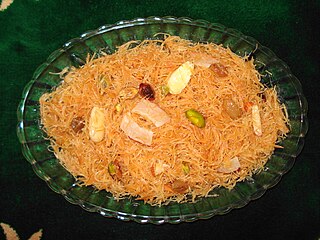
Sevai, shavige, saemia and santhakai is a type of rice vermicelli dish popular in India. While typically made from rice, varieties made out of other food grains like wheat, ragi, and others can also be found.

Hyderabadi cuisine, also known as Deccani cuisine, is the native cooking style developed in the kitchens of the Muslim aristocrats of the erstwhile Hyderabad State, India. The haute cuisine of Hyderabad began to develop after the foundation of the Bahmani Sultanate, and the Qutb Shahi dynasty centered in the city of Hyderabad promoted the native cuisine along with their own. Hyderabadi cuisine had become a princely legacy of the Nizams of Hyderabad as it began to further develop under their patronage.

Sheer khurma or sheer khorma is a festival vermicelli pudding prepared by Muslims on Eid ul-Fitr and Eid al-Adha in India, Pakistan, Afghanistan, and parts of Central Asia. It is equivalent to shemai, a Bangladeshi dessert. It is a traditional Muslim festive breakfast, and a dessert for celebrations. This dish is made from various dry fruits, vermicelli, condensed milk, sugar etc. Depending on the region, cardamom, pistachios, almonds, cloves, saffron, raisins, and rose water are also added.
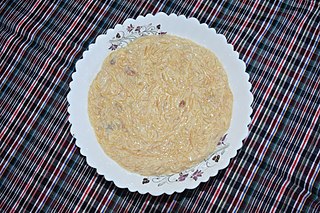
Both festivals of Eid celebrated in the Muslim world include cuisines specific to countries and localities.

Doodh pati chai is a tea beverage, originating from the Indian subcontinent, consumed in India, Pakistan, Bangladesh, Afghanistan and Nepal in which milk, together with sugar, is boiled with tea. Doodh pati is different from saada chai, in that it only uses milk and tea. This tea is quite common in South Asia. It is marginally costlier than the regular, water-based saada chai.
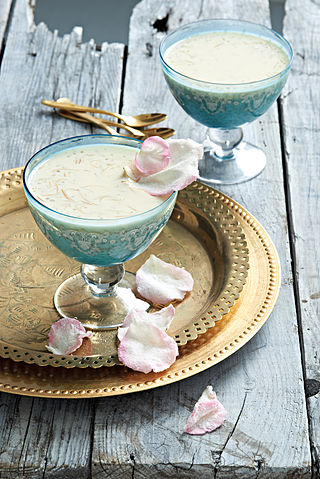
Boeber is the Cape Malay name for a South African pudding. It has become a traditional Cape Malay sweet, milk drink, made with vermicelli, sago, sugar, and flavoured with cardamom, stick cinnamon, and rose water. The pudding is traditionally served on the 15th night of Ramadan to celebrate the middle of the fast, for those who have completed the first 15 days of fasting. They are also known as people who are op die berg.
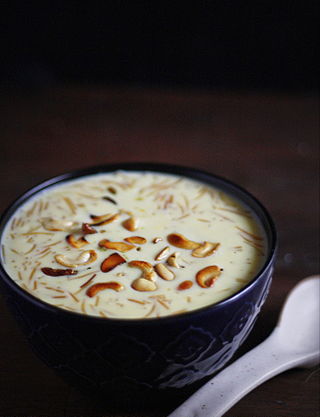
Shemai is a traditional dessert item in Bangladesh and West Bengal, India. Shemai is a popular item during Eid, but it's consumed throughout the year.. Shemai is a dessert form of Vermicelli, soaked in sweet milk and often garnished with nuts.

Lacassá Soup is a Macanese soup.
Chhadakhai is a ritual of Odisha celebrated on the next day of Kartik Purnima. Kartik month is considered a pious month and a lot of people do not consume non-veg food during this month. Chhadakhai word means having some food after a duration. Since people do not consume non-veg for the whole month of Kartik, they like to consume non-veg food on the very next day, Kartik month ends.
References
- ↑ Kumar Suresh Singh; B. V. Bhanu; Anthropological Survey of India (2004), People of India, Popular Prakashan, 2004, ISBN 978-81-7991-102-0,
... after consuming some sargi (fenia with milk and halva in the early hours) ...
- ↑ Dasa, Syamasundara (1965–1975). "Hindi sabdasagara". dsal.uchicago.edu. Retrieved 2022-12-17.